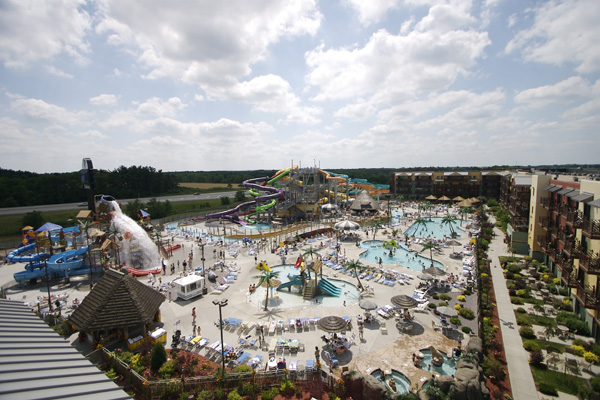High unemployment, crunched budgets and lower tax revenues have put financial stress on many locales. Those pressures can make a new waterpark very appealing.
Forget the fancy slides. While a new waterpark will need to wow visitors with all the latest technology once it opens, that day may never come unless local officials believe that the proposed park will bring jobs. “Three, four years ago, I don’t believe we had to emphasize the jobs piece so much,” says Craig Wilkinson, principal owner of Wisconsin Resort Consulting in Madison, Wis. “Ultimately, everybody wants jobs right now.”
With the national unemployment rate still higher than most economists would like at 7.7 percent in February 2013, many localities are hungry for new jobs. State budget crunches and depressed property tax revenues also have put financial stress on many cities and counties.
Those pressures can make a new waterpark an appealing prospect. “When you come in with an $18 million to $20 million payroll, 1,200 jobs and a tax base that solves their tax problems, most welcome you with open arms,” says Todd Nelson, owner and president of Kalahari Resorts in Wisconsin Dells, Wis., which has begun planning a new $350 million waterpark resort in Pennsylvania’s Pocono Mountains.
Such enthusiasm is critical for waterpark developers, who say public support is a crucial part of financing a new project.
“The most important thing to us is how we’re going to be received by the community and whether it will be an uphill battle,” says Jeff Henry, CEO of Schlitterbahn Waterparks and Resorts in New Braunfels, Texas. “We go to places where we are needed and wanted.”
However, even with a promising location and excited community, the development and financing of a large scale waterpark can still be a herculean undertaking.
Economic engine
A waterpark proposal offers the promise of serious tax dollars as well as a mix of temporary, seasonal and permanent jobs.
“It’s a large economic package,” says Wilkinson. “There are property taxes, hotel taxes, park taxes and retail taxes.”
The numbers illustrate why. In Wisconsin Dells, which has the highest concentration of waterparks in the country, the industry has helped build what is now a tax base of $1.1 billion for a city of only 2,700 residents.
That sounds mighty appealing to a place like Garden Grove, Calif., where local officials currently serve 175,000 residents on a tax base of just $42 million and can’t wait until Great Wolf opens its long planned 600-room waterpark hotel in the city. The Southern California city, located in the shadow of Anaheim’s Disneyland, spent years pursuing an attraction of its own and finally landed a Great Wolf Lodge in 2010.
“It’s a means to a better, more attractive and more financially solid community,” Garden Grove City Manager Matthew Fertal said of the waterpark when the project was announced. “It’s the shot in the arm every city wishes it had, especially in these economic times.”
Three years later, Fertal remains just as committed to the project, which promises to bring 600 jobs and $8.5 million in annual tax revenue to Garden Grove.
“It will be a huge economic engine for the city,” he says. “Right now, 12 hotels generate $12 million in hotel tax for us. This one [Great Wolf] hotel will generate $8.5 million.”
As the project’s size and scope increases, so does its potential economic impact. In the Poconos, the $350 million Kalahari project is estimated to create 1,200 construction jobs, 700 full- and part-time jobs at the resort and bring more than $18 million in tourism dollars to the surrounding area.
Public decisions
Depending on the project and locality, public officials have a number of tools to encourage a waterpark firm to develop a facility in their area.
“Waterpark developments have received a variety of economic incentives, including tax abatements, room tax rebates for waterpark resorts, infrastructure funds, income tax rebates, and assistance in acquiring land,” says David Sangree, president of consulting firm Hotel & Leisure Advisors in Cleveland, who does feasibility and economic impact studies for the waterpark industry. “It’s all about the metrics of the deal,” explains Henry. “If a project has great metrics, existing infrastructure, and is in a well developed area, then a city doesn’t need to offer as much.”
Garden Grove, for example, offered Great Wolf a $62 million package to locate its lodge there, agreeing to provide the company with $15 million worth of land, $5 million in cash, and $42 million in redevelopment bonds.
“Outside of hotel attendance and visitation, it’s been a flat economy for us,” Fertal says. “Thank goodness the hotels are performing well, otherwise we’d really be in bad shape. That’s why we’re willing to do this.”
Not everyone can.
“Several municipalities would like to do these [waterpark deals], but financially, they are so burdened, they can’t make it happen,” says Wilkinson, who evaluates deals for clients.
In the Poconos, Kalahari is hoping to tap into tax increment financing (TIF) for the project, which would help pay for infrastructure improvements such as utility lines and road improvements. While the details of tax increment financing can vary from locality to locality and state to state, Kalahari has used these tools before.
In Sandusky, Ohio, Kalahari relied on a TIF to pay for more than $7 million in infrastructure improvements for its resort there, according to the company. And in Corpus Christi, Texas, Schlitterbahn Waterparks and Resorts recently broke ground for a new $41 million waterpark that will be just one part of a larger $552 million mixed-use development that will take 18 years to build and produce $259 million in revenue.
Those are some big numbers, and the city’s contribution is no different; in exchange for the massive project, Corpus Christi agreed to provide $117 million in incentives, much of it in funds to promote tourism, for Schlitterbahn and its partners.
“As we looked at the economic impact, this was a good return,” says Foster Edwards, president of the Corpus Christi Chamber of Commerce. “Our economy is excellent, and we are not desperate by any means, but why turn down a good opportunity? It’s that simple.”
Officials at Garden Grove felt similarly about Great Wolf, whose project is expected to generate enough tax revenue to cover the cost of the $62 million economic development package within the city’s desired time frame of seven to 10 years.
“As long as the payback fits within that threshold, we feel that’s a reasonable return,” Fertal says.
Doing the deal
Why do public incentives matter so much in the private waterpark industry, which is a tourism sector that everyone says is growing? The answer is financing.
“The lending situation has never been easy,” Schlitterbahn’s Henry says. “I’ve always found it to be hard because waterparks are not considered mainstream financeable products, so you have to go to alternative label financing, which asks you to promise not only your firstborn, but also your second, third, and fourth child as well.”
But industry consultants say the lending situation has become especially challenging of late, with even major hospitality brands such as Marriott turning to alternative sources of construction financing for new projects.
Banks, so eager to lend during the economic boom, today seem leery of anything but the safest deals, and waterparks often combine the risks of real estate, hotel, and amusement park projects. As a result, a single lender may not be able or willing to provide all the debt that a waterpark company may need for a project.
“With the new rules in banking, projects can only go so large without getting many banks involved,” says Wilkinson. “Tax breaks that a project can take and monetize in some way are the best for a project. From my experience, most lenders are not going above 60 percent lending on projects. This means a project owner has to have 40 percent of the project in the deal. If this can be reduced by taking land off the costs or [using] state bonds, then that makes a project much more fundable.”
Public dollars can also make a waterpark more profitable, which also appeals to investors and lenders.
“We’re severely at risk on these projects, so everything we get makes it easier for us to get it built,” Henry says.
Of course, economic incentive packages have their own challenges. If a site or location is a bad bet for a waterpark due to demographics or other factors, public money probably won’t be enough to persuade a firm to take the risk.
“For us, the most important thing is that the project has got to make sense and be viable without incentives. No matter what incentives are offered, the plan and the project are the most important factors,” says Tim Black, COO of Great Wolf, which currently operates 10 waterpark resorts in the United States and one in Canada. Depending on how the incentives are structured, public money can also be slow, arriving only after a project has met certain targets or started generating tax revenue.
“You’re already so far into the deal [by the time the public dollars show up] that if the public financing falls through, you better be able to finish it,” Henry says.
It can also disappear, jeopardizing the project. That’s what happened in Garden Grove last fall, when Gov. Jerry Brown eliminated the state’s redevelopment agencies and put the city’s economic package to Great Wolf on uncertain ground.
“The waterpark hotel is one of the surviving projects that will keep our city financially afloat,” Fertal said at the time. “I can’t be more serious when I say that without it, our revenues may find themselves in rough waters.”
After a lengthy review process, the state in February agreed with Garden Grove that it was legally obligated to honor the agreement with Great Wolf. That put the project back on track and allowed Great Wolf to start pursuing its own financing.
Such deals also can be controversial, angering residents who think hiring teachers or firefighters is a better use of that money than helping a private waterpark, even if the funds are only available for economic redevelopment.
Clearly, tax breaks come with strings of their own, and smart waterpark executives acknowledge that.
“It’s not free money,” says Henry. “We know they’re giving us help to build a facility, and we owe that back to the people who we are serving.”
via Aquatics
We are extremely blessed to have the opportunity for Schlitterbahn Waterpark coming to our island, in the past few months we have seen great progress and look forward to the opening in Spring 2014. ~Cheri Sperling












